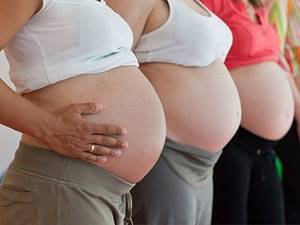Pregnancy in obese women
Obesity is the scourge of the modern world.
It can be both a cause and a consequence of various diseases. With obesity, the body accumulates excess fat, thereby increasing overall body weight. Checking yourself for the presence of excess fat is quite simple - for this, BMI (body mass index) is calculated. BMI = weight in kilograms / height in meters squared.
Next, check the result using the table:
Did you find your result in the table? There is nothing to congratulate you on; your health is at risk.
Excuses like “there must be a lot of good people”, “but there is something to hold on to”, “they love me too” are not accepted here. You need to be honest with yourself and admit - yes, I really have problems with weight!
Remember that for doctors of any specialty, you are a patient at high risk. Especially when it comes to planning, bearing and giving birth to a child.
Excessive fatness, as well as thinness, can prevent pregnancy. Therefore, before starting planning, all plump women, without exception, are recommended to visit a gynecologist-endocrinologist and undergo the tests prescribed by him. Doctors have long learned to correct hormonal levels with medications, and thanks to them, hundreds of thousands of women have learned the joy of motherhood.
Perhaps you were lucky and successfully conceived a child without medical intervention. Don’t relax, carefully monitor your health, visit doctors on time, remember that obesity is the cause of many complications during pregnancy.
Risks arising in obese pregnant women:
- Threat of spontaneous miscarriages in the first trimester;
- Increased blood pressure, as a result of which the fetus suffers from a lack of oxygen;
- Excess weight often causes hidden diabetes;
- The occurrence of late toxicosis;
- The likelihood of maternal stroke and other complications during childbirth.
And this is not a complete list of “troubles”, one of the reasons for which may be obesity.
How to find out your obesity level
Quite often, women tend to be biased about their figure. Often thin women exhaust themselves with diets, trying to adjust their appearance to the ideals of anorexic models. Sometimes, on the contrary, young ladies tend to underestimate the severity of the problem, naively believing that losing a couple - three, or even 20 - 30 kg will not be difficult.
To correctly assess your condition, the so-called body mass index was invented. It is calculated as follows: you need to divide your own mass in kilograms by your height in meters squared. For example, if you weigh 60 kg and are 155 cm tall, you need to divide 60 by 1.55 squared. That is, BMI = 60/2.4025 = 24.97.
Now you should check the obtained data with the
BMI
| Index | Features of your body |
| 16 or less | You are critically underweight |
| 16—18,5 | You don't have enough weight |
| 18,5—24,99 | You have a great figure |
| 25—30 | Slightly overweight |
| 30—35 | First degree obesity |
| 35—40 | Second degree obesity |
| 40 or more | Third degree obesity |
If your BMI is above 30, you should immediately take care of your own health. Especially if you are planning a pregnancy. Excuses like “there must be a lot of good people,” “a man is not a dog, he doesn’t throw himself at bones,” “everyone loves me like that,” etc. are no longer accepted. Forget about them, because now the health of your unborn baby may depend on your weight.
How to avoid problems and is this even possible?
Of course, the ideal would be to lose weight in advance, before pregnancy. But if you are already in a position, you need to pay attention to a few key points:
- 1. Constant supervision by specialists.
Yes, sometimes our doctors can be extremely tactless and even seem incompetent. However, this is not a reason to completely ignore medical support of pregnancy (with one caveat - if you are not a doctor yourself). Timely tests, blood pressure measurements and other seemingly pointless manipulations will help you and your baby maintain health, and sometimes even life.
Walking, doing chores around the house, and even playing sports, if there are no contraindications, do what brings you pleasure and joy. Pregnancy is not a disease, but a special state of the body. And if the body is healthy, you don’t have to limit it in loads.
The concept of a healthy lifestyle and proper nutrition are inextricably linked. Now is the time to reconsider your diet, because if you are overweight, it means you haven't been eating right. Focus on lean meats and fish, dairy products, plant foods and whole grains.
Eat, but not for two! During pregnancy, your weight will increase. If previously fat had a depressing effect on internal organs and the musculoskeletal system, now a growing uterus and a displaced center of gravity are added to its negative effects.
Keep your weight under control! If you are obese, you can gain no more than 6 kilograms during the entire pregnancy, if you are overweight - up to 10.

Problems and complications of overweight childbirth
While carrying a baby, the mother gains weight. What matters is the initial indicator and the number of kilograms gained. If it is excessive, the musculoskeletal system and internal organs suffer. It is difficult for the spine to withstand the load.
Overweight girls have an increased risk of miscarriage. Hypertension develops, uteroplacental exchange worsens, and vascular permeability decreases. The fetus does not receive enough nutrients and oxygen. Hypoxia and asphyxia develop.
The baby is born with low body weight, weak vital signs, and lags behind in mental and physical maturation. With latent diabetes, sugar levels increase. The fetus develops large, which leads to ruptures, bleeding, and mechanical damage to the embryo.
Even with a caesarean section, the birth of obese women occurs with pathologies. The baby's heartbeat cannot be heard. CTG and ultrasound are used. Against the background of obesity, the period of post-term pregnancy increases. Infectious and inflammatory diseases of the genitourinary system are noted. Obese women in labor have a high risk of postoperative scar suppuration.
Thrombosis of large vessels occurs due to deterioration of blood properties. High percentage of frozen pregnancies and spontaneous abortion. Perinatal mortality occurs in 15% of cases. The cause is premature placental abruption.
Problems appear in the baby. These include congenital developmental anomalies, heart defects, and neural tube defects. Children have autoimmune diseases and diabetes. Obesity of a pregnant mother leads to macrosomia. The fetal weight increases, and the baby is prone to accumulating excess body weight.
Childbirth in obese women
According to statistics, the most common complication during childbirth for obese women is premature rupture of amniotic fluid in combination with weak or absent labor.
And although obesity is not a direct indication for a cesarean section, the likelihood of stroke, uterine bleeding, and fetal hypoxia makes this operation the only option for delivery in 20% of obese women.
During natural childbirth, doctors adhere to active management tactics, i.e. drug stimulation. It is carried out no later than 39-40 weeks, since in obese women there is a tendency to post-term pregnancy, fetal hypoxia and the birth of large children, and, as a consequence, to injuries to the mother and (or) child.
As you can see, excess weight is not only an aesthetic problem, but also a serious threat to health in general and motherhood in particular. Naturally, a couple of extra pounds is not a reason to panic; sometimes they only decorate a woman, giving her shape a pleasant roundness and exciting outline. Pregnancy and obesity are not antonyms, but when planning to become a mother, you must take into account all medical aspects and be prepared to fight the kilograms.
Health to you and your children!
Journalist, graduated from the school of medical journalism, collaborates with the Media Institute of Public Health. Specializes in the following topics: obstetrics, gynecology, reproductive medicine, urology, psychology
Childbirth in overweight women
Most often, overweight mothers experience weak labor and premature rupture of amniotic fluid. In particularly severe cases, the risk of hypoxia, stroke and uterine hemorrhage rapidly increases. Therefore, approximately 20 percent of obese mothers are prescribed a cesarean section. Doctors often also stimulate labor with medication. This is due to the fact that plump young ladies, in most cases, carry their babies to term, and this, in turn, negatively affects the health of the baby and subsequent births.
Weight during pregnancy: normal, causes of underweight and excess body weight
A balanced diet and vitamin and mineral complexes created specifically for each trimester of pregnancy can help you get the necessary microelements without gaining excess weight.
Excess weight during pregnancy can be associated with edema. Taking multivitamins that contain rutin helps reduce leg swelling.
The Complivit ® Trimester line was created taking into account the characteristics of each stage of pregnancy. The complex contains the most important vitamins and minerals, including folic acid, iodine, iron, rutin and lutein in special doses for each trimester.
To learn more.
Become a better mother from the first thought about your baby.
The weight of a newborn baby fits within a fairly narrow framework, but weight gain by an expectant mother is an individual indicator and depends on many factors. Often, after giving birth, a woman discovers that she has gained excess weight; occasionally, on the contrary, it turns out that her weight has noticeably decreased after pregnancy. What determines body weight during pregnancy, what are the norms for weight gain, and what to do if weight increases too quickly or too slowly?
Pregnancy is a new stage in a woman’s life, and, of course, eating behavior during this period changes greatly: some begin to eat without denying themselves anything, and after giving birth they discover that they have gained extra pounds. Others, on the contrary, experience severe toxicosis in the first trimester, eat moderately and selectively, and after the birth of the child they realize that they have lost a lot of weight. In any case, the expectant mother needs to receive all the necessary vitamins and minerals so that both she and the baby remain healthy.
What are the normal weight standards during pregnancy? Read the article.
On a note
The need for vitamins and minerals during pregnancy increases by approximately 25–40%. This is necessary for normal growth and development of the fetus. Moreover, energy demand increases by only 10%. Therefore, pregnant women are often prescribed special vitamins and minerals to fully support the health of mother and baby. In addition, it is worth considering that a vitamin-mineral complex (VMC) for pregnant women must be a product that has passed the necessary clinical trials.
How weight changes during pregnancy: rate of weight gain for mother and child by week
Weight gain during pregnancy is not only due to fetal growth. Its weight makes up only 25–30% of the total weight gained. Approximately the same amount is accounted for by fat deposits, which are necessary to support the mother’s body during pregnancy and feeding. 10% is the weight of amniotic fluid, and the same amount is due to the enlarged uterus - by the last weeks of pregnancy its weight reaches up to a kilogram. Approximately 25% of the weight gained during pregnancy is extra blood and intercellular fluid, as well as glandular tissue of the mammary glands. We must not forget about the placenta: its weight is approximately 5%.
Weight gain during pregnancy depends significantly on the woman's pre-pregnancy weight (see Table 1). To more accurately determine weight before pregnancy, you should use the body mass index (BMI), which is calculated using the formula:
BMI = weight (kg) / height 2 (m 2 )
So, with a BMI of less than 18.5, you are underweight, with a BMI of 18.5 to 25, you are normal weight, with a BMI of 25 to 30, you are overweight, and with a BMI of more than 30, you are obese.
Pregnancy in obese women
Excess weight has never graced a woman. Each of us wants to be slim, beautiful and desirable. True, not everyone strives for this. There are, of course, women who are slightly overweight; their loved ones like them that way and, in general, are quite satisfied with themselves. But excess weight does not have the best effect on your health. Especially when it comes to overweight and obesity. In this case, a number of disruptions in the functioning of organs and systems occur in the body, leading to the development of all kinds of diseases. Hormonal levels are also disrupted. You may have noticed that overweight women often have increased male-type hair growth (particularly on the face), and they also often have an almost masculine, rough voice.
In general, if a woman wants to be not only beautiful, but also healthy, she definitely needs to monitor her weight and keep it within limits. And if a woman also wants to give birth to healthy children, the issue should be approached with special responsibility.
Fighting excess weight before conception
For those whose weight exceeds the norm by 5-8 kg, we can recommend sticking to proper nutrition, going to the gym, joining a swimming pool and spending more time outdoors. At first, it will be difficult for the body to adapt to the new rhythm.
For example, if you are used to eating a lot of carbohydrates, then reducing your consumption of sweets and starchy foods will not be easy. Try to limit yourself and listen to your body. Why do we overeat? The reason is that most of us eat not to fill ourselves up, but to get pleasure. Perhaps you have some free time, you are bored, or you are eating an extra piece for company. But most of us are not familiar with the real feeling of hunger.
Let's try to understand our body and feel when we need to start eating. To do this you need to give up dinner. Let breakfast be the usual, and for lunch, reduce the serving size by a third. By evening, the body will immediately give a signal - it will be a slight hunger, which means it’s time to start eating.
Remember that while preparing lunch or dinner, it is not advisable to taste food often. If you have tasted the dish several times, then the number of servings during the meal should be reduced.
Do you feel like you don't want to eat? And there is no need, wait until you feel slightly hungry, and only then sit down at the table. Do not rush to pounce on food, take a bite of food and chew slowly, enjoying the taste. At the same time, do not forget to analyze your feelings. If you don’t feel like eating, you can stop there. Just remember that hunger and thirst are not the same thing. Don't forget to drink plenty of water. For the body, the norm is 2 liters per day, and for obese people - 2.5-3 liters. try to drink purified water without gas, ignore carbonated sweet drinks (even Coca-Cola labeled “0 calories” contains artificial sugar substitutes).
Pay attention to the quality of the food. You like this mayonnaise or sausage because of the taste. Have you ever thought about the fact that many products contain flavor enhancers (special additives)? Having tasted a little, a person will again reach for a new portion. Therefore, you should refrain from eating such foods (sweets, drinks, sausage, cakes). Instead, steam your vegetables, make a fresh salad, and swap the soda for a glass of herbal tea.
As you can see, getting closer to your dream and becoming slimmer is not so difficult; the main thing is a great desire to become a mother, safely carry and give birth to a healthy baby.
Excess weight has never graced a woman. Each of us wants to be slim, beautiful and desirable. True, not everyone strives for this. There are, of course, women who are slightly overweight; their loved ones like them that way and, in general, are quite satisfied with themselves. But excess weight does not have the best effect on your health. Especially when it comes to overweight and obesity. In this case, a number of disruptions in the functioning of organs and systems occur in the body, leading to the development of all kinds of diseases. Hormonal levels are also disrupted. You may have noticed that overweight women often have increased male-type hair growth (particularly on the face), and they also often have an almost masculine, rough voice.
In general, if a woman wants to be not only beautiful, but also healthy, she definitely needs to monitor her weight and keep it within limits. And if a woman also wants to give birth to healthy children, the issue should be approached with special responsibility.
Obesity is a threat to pregnancy
Fatness and pregnancy are almost related concepts. Because normally, a woman will certainly gain additional weight during pregnancy. Another thing is what this increase will be and what its initial weight will be.
Excessive weight primarily places a very heavy load on the musculoskeletal system and all internal organs. It is difficult for the spine to bear such a burden. And this is fraught with problems. In addition, it is known that obese women are more likely than others to suffer from infertility. And during pregnancy, their risk of miscarriage increases. Hypertension, which often develops in obese women, also poses a serious danger. Because of this, the uteroplacental exchange deteriorates, the permeability of blood vessels decreases, and the fetus cannot receive sufficient nutrients and oxygen, which causes the development of hypoxia and asphyxia during childbirth. A particular risk arises during childbirth, when a sharp increase in blood pressure can not only cause oxygen starvation for the baby, but also lead to a stroke in the mother. If a child experiences hypoxia in the womb, then most often he is born with low body weight and low vital signs, the central nervous system suffers, convulsions occur, and there is a lag in mental and physical development.
Obesity can cause the development of so-called latent diabetes in a pregnant woman (if not true diabetes mellitus). Due to the increased sugar content in the blood, the fetus develops quite large, which promises certain problems during childbirth: severe ruptures and bleeding in the mother, mechanical damage to the fetus due to the large weight of the mother and child. Therefore, most often the mother’s obesity is an indicator for a caesarean section. Yes, and excess weight also promises certain health problems for a child.
Pregnancy in obese women - What to be afraid of?
Every year, more and more women face the problem of being overweight or even obese. This tendency is associated with hormonal disorders, poor nutrition, and the absorption of unhealthy high-calorie foods. Most people do not follow a meal schedule. You need to eat 3-4 times a day in small, balanced portions. In addition, a passive lifestyle aggravates the situation.
The problem of extra pounds not only affects a woman’s appearance, but also her health. This can become a serious problem for conceiving a child and further bearing it.

An overweight woman must take measures to reduce it. An examination by an endocrinologist and advice from an experienced nutritionist who will prescribe the necessary medications and develop an individual diet and diet plan can help with this. It is important during this period to actively saturate the body with vitamins, especially folic acid.
There is a high probability that excess weight can cause infertility in a woman, and in an already pregnant woman the following complications:
- - high risk of miscarriage;
- — significant load on the musculoskeletal system, as well as internal organs;
- - the development of hypertension (provoke poor utero-placental exchange) can cause insufficient oxygen supply to the fetus, hypoxia and asphyxia. During childbirth, blood pressure can jump sharply, which can cause oxygen starvation in the fetus, and also lead to a stroke for the woman in labor. Hypoxia can be the reason why a child is born with a small weight and weak vital signs, and also suffers from the central nervous system. There are cases when a child experiences convulsions or is delayed in mental and physical development.
- — pregnancy can be accompanied by severe toxicosis. The woman suffers from swelling, cramps;
- - development of latent diabetes. The child grows large, as a consequence of childbirth there are severe ruptures and increased bleeding in the woman in labor; damage to the child himself due to his and the mother’s high weight.
- - if a large fetus is expected, then, as a rule, a caesarean section is used. A massive layer of fat can make this procedure difficult.
Of course, you should not be afraid that a woman will have all these complications at the same time. In addition, there are cases when a plump girl, having become pregnant, begins to lose weight. These cases are possible when excess weight is caused by metabolic disorders in the body. During the period of bearing a child, metabolism is adjusted under the influence of previously inactive hormones. As a result, a pregnant girl may not gain weight, but lose it - from 12 to 15 kg.
Many women are afraid that the weight they previously lost may return after childbirth. But this is not the case if you eat right.
But you shouldn’t hope that you will fall into the category of such women. Better start changing your body and lifestyle immediately. As a reward - you will lose the troubles during pregnancy and will find a strong, healthy baby.
If you are already pregnant, but have not had time to lose weight, it’s okay. An obese woman is able to give birth to a healthy child, subject to certain rules. Namely:
- - register early at the antenatal clinic; - measure blood pressure daily;
- - eat healthy food in small portions, but often (mainly of plant origin); - be sure to take a walk, do the exercises that the doctor recommends;
- - undergo an ultrasound and pass all tests.
By following all these instructions, a woman will certainly make the course of pregnancy and the birth itself easier.
Where do fat reserves come from? Excess weight during pregnancy.
Obesity is not just excess fat in the body. This is a chronic relapsing (with exacerbations) disease that contributes to the manifestation and development of many other chronic diseases. This disease also affects the course of pregnancy.
Natalya Alexandrova: “The main sign of obesity is excessive accumulation of adipose tissue in the body. Adipose tissue is a depot (place of accumulation) of incoming energy. The more adipose tissue, the higher the amount of “extra” energy obtained from food and not spent.”
Where do fat reserves come from?
The factors for the development of obesity are diverse and can act both jointly and separately. The most common of them are behavioral characteristics (physical inactivity - decreased physical activity, overeating), genetic predisposition, and endocrine system disorders. Numerous studies have found that obesity in childhood is a powerful predisposing factor for obesity in adulthood, especially when one or both parents are affected. Thus, with normal body weight of parents, obesity occurs only in 9% of children, with obesity of one parent - in 50%, and with obesity of both parents - in 70% of cases.
There is a special center in the brain, the hypothalamus, which is responsible for the feeling of hunger and satiety. Constant overeating leads to disruption of the hypothalamus, and the normal amount of food eaten can no longer suppress the feeling of hunger, so a person has to eat more and more. Excess food is stored as if in reserve in the fat depot, which leads to an increase in the amount of fat in the body, that is, to the development of obesity.
How much weight is overweight?
In our country, the degree of obesity is usually determined using Brock's formula: body weight = height in cm - 100. Excess body weight up to 30% is classified as I degree of obesity, from 30 to 50% - to the second, from 50 to 100% - to the third degree and more than 100% - by the fourth.
So, with a height of 170, the weight should not exceed 70 kg, I degree obesity occurs with a weight of up to 91 kg, II degree - up to 105 kg, III degree - up to 140, IV degree - more than 140 kg.
Western doctors prefer to use body mass index (BMI), which is defined as the ratio of body weight (in kg) to height (in m2). BMI indicators from 25 to 30 kg/m2 indicate overweight, and more than 30 kg/m2 already allow a diagnosis of obesity.
Possible problems
Pregnancy.
During pregnancy, favorable conditions are created for the development of fatty tissue, the biological meaning of which is to protect the unborn child. This is due to hormonal changes in a woman’s body, namely increased synthesis of progesterone and human chorionic gonadotropin (hormones that support pregnancy) and a deficiency of estradiol, produced by the ovaries mainly outside of pregnancy. The action of these hormones causes the deposition of adipose tissue mainly in the area of the mammary glands, buttocks, thighs, and abdomen.
In obese patients, pregnancy rarely proceeds without complications. The most common include gestational diabetes, or diabetes during pregnancy, arterial hypertension, hypercoagulation (increased blood clotting), cardiac dysfunction, toxicosis, preeclampsia (it is characterized by increased blood pressure, the appearance of edema, protein in the urine), urinary tract infections, miscarriage or post-term pregnancy. pregnancy (a condition in which pregnancy lasts more than 41-42 weeks), premature rupture of amniotic fluid, the birth of a child with a large body weight (more than 4000 g).
The most dangerous complication is preeclampsia - the most severe form of gestosis, the main symptoms of which are an increase in systolic pressure above 140 mmHg. Art., diastolic pressure above 80 mm Hg. Art., as well as proteinuria (loss of more than 3 g of protein per day in urine). In addition to the above symptoms, there may be signs of damage to other systems and organs: the appearance of headaches, abdominal pain, blurred vision. Laboratory tests reveal increased levels of liver enzymes and changes in the blood coagulation system.
Obesity also affects child development. As is known, folic acid plays a key role in the formation of the nervous system, and with obesity, its metabolism in the body of a pregnant woman changes, which can lead to the development of defects of the nervous system in the fetus.
Childbirth.
In obese women, not only pregnancy, but also childbirth itself occurs with a number of peculiarities, which is caused by hormonal changes. The internal system that triggers labor in such women remains imperfect by the end of pregnancy, and the lack of formation of a labor dominant (a focus of excitation in the brain) leads to post-term pregnancy, and subsequently to weakness of labor, the severity of which increases in proportion to the degree of obesity.
When labor is weak and cannot be corrected with medication, doctors are forced to resort to surgical delivery (caesarean section or forceps) to avoid acute oxygen deprivation in the newborn. But it is possible that the need for a cesarean section will be due to a discrepancy between the sizes of the pelvis of the mother and the fetus, since obese pregnant women, as mentioned above, are more likely to give birth to children with a large body weight.
In turn, surgical intervention is also associated with a large number of complications, since the severity of the subcutaneous fat layer impairs the healing of postoperative scars
You can purchase clever scales that analyze the mass of fat, muscles, and bones. During pregnancy, these scales can only be used for weighing, since they have not yet “learned” to take into account the weight of the fetus, placenta, and amniotic fluid.
In 6-30% of obese women in labor, bleeding occurs during childbirth, as well as in the postpartum period, the causes of which are both impaired contractility of the uterus and changes in the blood coagulation system.
It should also be remembered that obese women are at risk of developing carbohydrate metabolism disorders, that is, diabetes mellitus, therefore, 2 months after childbirth or after cessation of lactation, they need to be examined to determine blood glucose levels.
Big belly during pregnancy: reasons
With the development of the embryo, the amount of intrauterine fluid, and the enlargement of the uterus, the growth of the abdomen is activated.
From the 20th week, the leading gynecologist carries out routine measurements of the circumference of the abdomen and fundus of the uterus, according to which he determines the intrauterine development of the child. Deviations from the norm towards a decrease or increase in volume indicate a possible pathology, requiring a thorough examination. What does a big belly mean during pregnancy, and what are the causes of an overly rounded belly? Experts report that a large abdominal circumference during pregnancy depends on the following factors:
- polyhydramnios;
- incorrect position of the fetus;
- presence of infectious diseases;
- pathologies of placenta formation;
- multiple pregnancy;
- large fruit;
- genetic predisposition;
- mommy's body structure;
- general weight gain, metabolic disorders.
Polyhydramnios is one of the indicators of a large belly during pregnancy.
Often, the circumference of the belly with an increased level of water in the womb reaches 100-120 cm at the level of the umbilical cavity, the formation of stretch marks is possible, as well as the occurrence of some gurgling from it. This condition is characterized by an excess of amniotic fluid, which leads to a number of negative situations: termination of pregnancy, premature birth, late toxicosis, the development of defects in the child’s central nervous system and gastrointestinal tract. It should be noted that it is the increased volume of fluid in the womb that is the key link in the chain of factors that influence the formation of a voluminous abdomen. Due to polyhydramnios, the intrauterine space increases at times, which can lead to incorrect positioning of the baby (oblique, transverse presentation), too large a belly during pregnancy. To eliminate the possibility of death of the mother/child, in such a situation, specialists resort to surgical intervention. The presence of an infection in the mother’s body or improper development of the placenta contributes to abnormal ripening of the uterus. As a result, women can develop either a miniature or a huge belly during pregnancy. Factors in the formation of a large belly are metabolic disorders (possible increase in blood sugar levels), due to which women rapidly gain weight, and a large fetus is formed. Weight gain is also observed due to increased swelling, so pregnant women should minimize water consumption at night and eliminate salty foods and salts in general. Uncontrolled food consumption, unbalanced nutrition, and the “sloth position” during pregnancy lead to an increase in the girl’s body weight and the formation of a mega-huge belly. Therefore, for physically unprepared women in labor, the birth process is very difficult. Most often, a large belly in women is formed during multiple pregnancies. At approximately 28 weeks, the abdominal volume reaches prenatal size, and at 30-32 weeks it grows to its greatest extent. The reason why the belly is larger than the duration of pregnancy is the woman’s genetic predisposition, constitution, body structure: in fragile women, as a rule, the belly is much larger than in overweight ones. There is an opinion that during the second or third pregnancy the belly is larger in size than during the first, and the fetus is much larger. It is not possible to unequivocally agree with this judgment. Every pregnancy is individual and proceeds according to its own plan. But, often, this is what happens: every subsequent pregnancy is characterized by an increase in the volume of the belly, the birth of a larger child.
An explanation for a voluminous belly during repeated pregnancy is the argument that the muscles of the uterus and abdominal wall are weakened, and under the pressure of the baby, the amount of water decreases, visually making the belly saggy and large in scale.











